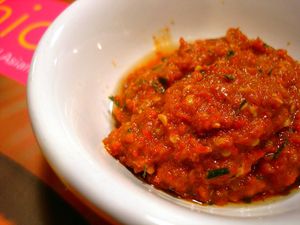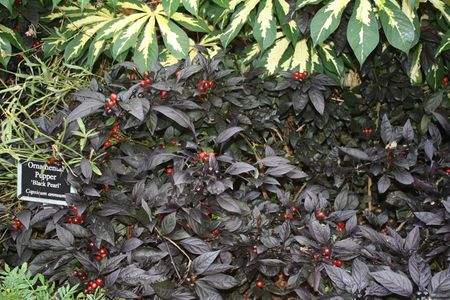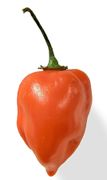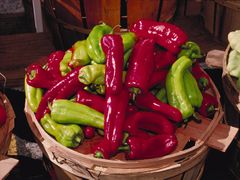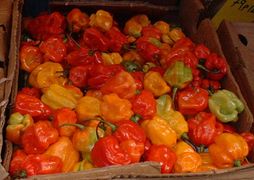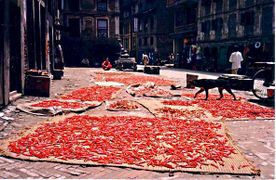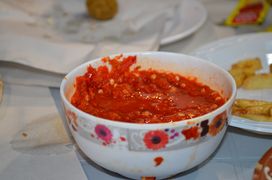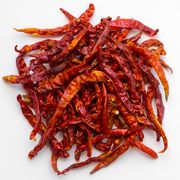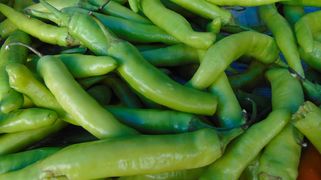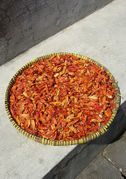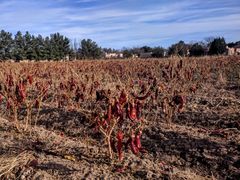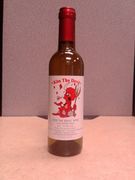فلفل حار
| Chili | |
|---|---|

| |
| التصنيف العلمي | |
| أصنوفة غير معروفة (أصلحها): | Capsicum |
| Species: | Template:Taxonomy/CapsicumC. annuum
|
| Binomial name | |
| Template:Taxonomy/CapsicumCapsicum annuum | |
| Varieties and Groups | |
| |
| Synonyms[3] | |
|
Synonymy
| |
فلفل أحمر هونبات حولي من الفصيلة الباذنجانية ، يزرع في المناطق الحارة في العالم، وهو من النباتات العشبية المعمرة. يصل ارتفاع الساق إلى 150 سم، وهى غزيرة التفريع ذات فروع مضلعة الشكل خضراء اللون تحمل أوراقا قليلة بيضاوية الشكل، وأما الأزهار فصغيرة الحجم تخرج في مجموعات لونها أبيض أو أرجوانى، والثمار رفيعة مدببة القمة لونها أحمر بعد النضج تحتوى على بعض الجلوكسيدات الملونة وفيتامين ج وزيت طيار مجهول التركيب ومادة فعالة بنسبة 2 % وصبغ الكاروتين، ومن المعروف أن المادة الفعالة ذات الطعم الحريف تزداد شدتها كلما أصبحت الثمرة تامة النضج.
. . . . . . . . . . . . . . . . . . . . . . . . . . . . . . . . . . . . . . . . . . . . . . . . . . . . . . . . . . . . . . . . . . . . . . . . . . . . . . . . . . . . . . . . . . . . . . . . . . . . . . . . . . . . . . . . . . . . . . . . . . . . . . . . . . . . . . . . . . . . . . . . . . . . . . . . . . . . . . . . . . . . . . . .
Production
| Green chili production – 2016 | |
|---|---|
| Country | (millions of tonnes) |
Worldwide in 2016, 34.5 million tonnes of green chili peppers and 3.9 million tonnes of dried chili peppers were produced.[4] China was the world's largest producer of green chilis, providing half of the global total. Global production of dried chili peppers was about one ninth of fresh production, led by India with 36% of the world total.[4]
Species and cultivars

There are five domesticated species of chili peppers. Capsicum annuum includes many common varieties such as bell peppers, wax, cayenne, jalapeños, chiltepin, and all forms of New Mexico chile. Capsicum frutescens includes malagueta, tabasco and Thai peppers, piri piri, and Malawian Kambuzi. Capsicum chinense includes the hottest peppers such as the naga, habanero, Datil and Scotch bonnet. Capsicum pubescens includes the South American rocoto peppers. Capsicum baccatum includes the South American aji peppers.[5]
Though there are only a few commonly used species, there are many cultivars and methods of preparing chili peppers that have different names for culinary use. Green and red bell peppers, for example, are the same cultivar of C. annuum, immature peppers being green. In the same species are the jalapeño, the poblano (which when dried is referred to as ancho), New Mexico, serrano, and other cultivars.
Peppers are commonly broken down into three groupings: bell peppers, sweet peppers, and hot peppers. Most popular pepper varieties are seen as falling into one of these categories or as a cross between them.
Intensity

The substances that give chili peppers their pungency (spicy heat) when ingested or applied topically are capsaicin (8-methyl-N-vanillyl-6-nonenamide) and several related chemicals, collectively called capsaicinoids.[6][7] The quantity of capsaicin varies by variety, and on growing conditions. Water stressed peppers usually produce stronger pods. When a habanero plant is stressed, by absorbing low water for example, the concentration of capsaicin increases in some parts of the fruit.[8]
When peppers are consumed by mammals such as humans, capsaicin binds with pain receptors in the mouth and throat, potentially evoking pain via spinal relays to the brainstem and thalamus where heat and discomfort are perceived.[9] The intensity of the "heat" of chili peppers is commonly reported in Scoville heat units (SHU). Historically, it was a measure of the dilution of an amount of chili extract added to sugar syrup before its heat becomes undetectable to a panel of tasters; the more it has to be diluted to be undetectable, the more powerful the variety, and therefore the higher the rating.[10] The modern method is a quantitative analysis of SHU using high-performance liquid chromatography (HPLC) to directly measure the capsaicinoid content of a chili pepper variety. Pure capsaicin is a hydrophobic, colorless, odorless, and crystalline-to-waxy solid at room temperature, and measures 16,000,000 SHU.
Capsaicin is produced by the plant as a defense against mammalian predators and microbes, in particular a fusarium fungus carried by hemipteran insects that attack certain species of chili peppers, according to one study.[11] Peppers increased the quantity of capsaicin in proportion to the damage caused by fungal predation on the plant's seeds.[11]
Common peppers
A wide range of intensity is found in commonly used peppers:
| Bell pepper | 0 SHU |
| New Mexico green chile | 0–70,000 SHU |
| Fresno, jalapeño | 3,500–10,000 SHU |
| Cayenne | 30,000–50,000 SHU |
| Piri piri | 50,000–100,000 SHU |
| Habanero, Scotch bonnet, bird's eye | 100,000–350,000 SHU[12] |
Notable hot chili peppers
Some of the world's hottest chili peppers are:
 الولايات المتحدة | Pepper X | 3.18M SHU(*)[13]
الولايات المتحدة | Pepper X | 3.18M SHU(*)[13]
 ويلز | Dragon's Breath | 2.4M SHU(*)[14]
ويلز | Dragon's Breath | 2.4M SHU(*)[14]
 الولايات المتحدة | Carolina Reaper | 2.2M SHU(*)[15]
الولايات المتحدة | Carolina Reaper | 2.2M SHU(*)[15]
- قالب:Country data Trinidad | Trinidad moruga scorpion | 2.0M SHU(*)[16]
 الهند | Bhut jolokia (Ghost pepper) | 1.58M SHU[17]
الهند | Bhut jolokia (Ghost pepper) | 1.58M SHU[17]
- قالب:Country data Trinidad | Trinidad Scorpion Butch T | 1.463M SHU[18]
 إنگلترة | Naga Viper | 1.4M SHU[19]
إنگلترة | Naga Viper | 1.4M SHU[19]
 إنگلترة | Infinity chili | 1.2M SHU[20]
إنگلترة | Infinity chili | 1.2M SHU[20]
NOTE: SHU claims marked with an asterisk (*) has not been confirmed by Guinness World Records.[21]
Uses
Culinary uses
Chili pepper pods, which are berries, are used fresh or dried. Chilies are dried to preserve them for long periods of time, which may also be done by pickling.
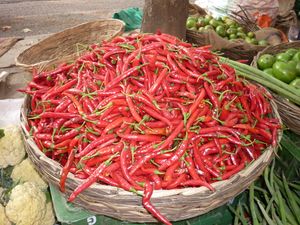
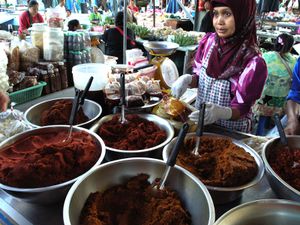
Dried chilies are often ground into powders, although many Mexican dishes including variations on chiles rellenos use the entire chili. Dried whole chilies may be reconstituted before grinding to a paste. The chipotle is the smoked, dried, ripe jalapeño.
Many fresh chilies such as poblano have a tough outer skin that does not break down on cooking. Chilies are sometimes used whole or in large slices, by roasting, or other means of blistering or charring the skin, so as not to entirely cook the flesh beneath. When cooled, the skins will usually slip off easily.
The leaves of every species of Capsicum are edible. Though almost all other Solanaceous crops have toxins in their leaves, chili peppers do not.[بحاجة لمصدر] The leaves, which are mildly bitter and nowhere near as hot as the fruit, are cooked as greens in Filipino cuisine, where they are called dahon ng sili (literally "chili leaves"). They are used in the chicken soup tinola.[22] In Korean cuisine, the leaves may be used in kimchi.[23] In Japanese cuisine, the leaves are cooked as greens, and also cooked in tsukudani style for preservation.
Chili is a staple fruit in Bhutan. Bhutanese call this crop ema (in Dzongkha) or solo (in Sharchop). The ema datsi recipe is entirely made of chili mixed with local cheese.
In India, most households always keep a stock of fresh hot green chilies at hand, and use them to flavor most curries and dry dishes. It is typically lightly fried with oil in the initial stages of preparation of the dish. Some states in India, such as Rajasthan, make entire dishes only by using spices and chilies.[بحاجة لمصدر]
Chilies are present in many cuisines. Some notable dishes other than the ones mentioned elsewhere in this article include:
- Arrabbiata sauce from Italy is a tomato-based sauce for pasta always including dried hot chilies.
- Puttanesca sauce is tomato-based with olives, capers, anchovy and, sometimes, chilies.
- Paprikash from Hungary uses significant amounts of mild, ground, dried chilies, known as paprika, in a braised chicken dish.
- Chiles en nogada from the Puebla region of Mexico uses fresh mild chilies stuffed with meat and covered with a creamy nut-thickened sauce.
- Curry dishes usually contain fresh or dried chiles.
- Kung pao chicken (Mandarin Chinese: 宫保鸡丁 gōng bǎo jī dīng) from the Sichuan region of China uses small hot dried chilies briefly fried in oil to add spice to the oil then used for frying.
- Mole poblano from the city of Puebla in Mexico uses several varieties of dried chilies, nuts, spices, and fruits to produce a thick, dark sauce for poultry or other meats.
- Nam phrik are traditional Thai chili pastes and sauces, prepared with chopped fresh or dry chilies, and additional ingredients such as fish sauce, lime juice, and herbs, but also fruit, meat or seafood.
- 'Nduja, a more typical example of Italian spicy specialty, from the region of Calabria, is a soft pork sausage made "hot" by the addition of the locally grown variety of jalapeño chili.
- Paprykarz szczeciński is a Polish fish paste with rice, onion, tomato concentrate, vegetable oil, chili pepper powder and other spices.
- Sambal terasi or sambal belacan is a traditional Indonesian and Malay hot condiment made by frying a mixture of mainly pounded dried chili s, with garlic, shallots, and fermented shrimp paste. It is customarily served with rice dishes and is especially popular when mixed with crunchy pan-roasted ikan teri or ikan bilis (sun-dried anchovies), when it is known as sambal teri or sambal ikan bilis. Various sambal variants existed in Indonesian archipelago, among others are sambal badjak, sambal oelek, sambal pete (prepared with green stinky beans) and sambal pencit (prepared with unripe green mango).
- Som tam, a green papaya salad from Thai and Lao cuisine, traditionally has, as a key ingredient, a fistful of chopped fresh hot Thai chili, pounded in a mortar.
Fresh or dried chilies are often used to make hot sauce, a liquid condiment—usually bottled when commercially available—that adds spice to other dishes. Hot sauces are found in many cuisines including harissa from North Africa, chili oil from China (known as rāyu in Japan), and sriracha from Thailand. Dried chilies are also used to infuse cooking oil.
. . . . . . . . . . . . . . . . . . . . . . . . . . . . . . . . . . . . . . . . . . . . . . . . . . . . . . . . . . . . . . . . . . . . . . . . . . . . . . . . . . . . . . . . . . . . . . . . . . . . . . . . . . . . . . . . . . . . . . . . . . . . . . . . . . . . . . . . . . . . . . . . . . . . . . . . . . . . . . . . . . . . . . . .
Ornamental plants
The contrast in color and appearance makes chili plants interesting to some as a purely decorative garden plant.
- Black pearl pepper: small cherry-shaped fruits and dark brown to black leaves
- Black Hungarian pepper: green foliage, highlighted by purple veins and purple flowers, jalapeño-shaped fruits[24]
- Bishop's crown pepper, Christmas bell pepper: named for its distinct three-sided shape resembling a red bishop's crown or a red Christmas bell[25]
Psychology
Psychologist Paul Rozin suggests that eating chilies is an example of a "constrained risk" like riding a roller coaster, in which extreme sensations like pain and fear can be enjoyed because individuals know that these sensations are not actually harmful. This method lets people experience extreme feelings without any significant risk of bodily harm.[26]
Medicinal
Capsaicin, the chemical in chili peppers that makes them hot, is used as an analgesic in topical ointments, nasal sprays, and dermal patches to relieve pain.[27]
Chemical irritants
Capsaicin extracted from chilies is used in manufacturing pepper spray and tear gas as chemical irritants, forms of less-lethal weapons for control of unruly individuals or crowds.[28] Such products have considerable potential for misuse, and may cause injury or death.[28]
Crop defense
Conflicts between farmers and elephants have long been widespread in African and Asian countries, where elephants nightly destroy crops, raid grain houses, and sometimes kill people. Farmers have found the use of chilies effective in crop defense against elephants. Elephants do not like capsaicin, the chemical in chilies that makes them hot. Because the elephants have a large and sensitive olfactory and nasal system, the smell of the chili causes them discomfort and deters them from feeding on the crops. By planting a few rows of the pungent fruit around valuable crops, farmers create a buffer zone through which the elephants are reluctant to pass. Chili dung bombs are also used for this purpose. They are bricks made of mixing dung and chili, and are burned, creating a noxious smoke that keeps hungry elephants out of farmers' fields. This can lessen dangerous physical confrontation between people and elephants.[29]
Food defense
Birds do not have the same sensitivity to capsaicin, because it targets a specific pain receptor in mammals. Chili peppers are eaten by birds living in the chili peppers' natural range, possibly contributing to seed dispersal and evolution of the protective capsaicin in chili peppers.[30]
Nutritional value
| القيمة الغذائية لكل 100 g (3.5 oz) | |
|---|---|
| الطاقة | 166 kJ (40 kcal) |
8.8 g | |
| Sugars | 5.3 g |
| ألياف غذائية | 1.5 g |
0.4 g | |
1.9 g | |
| الڤيتامينات | |
| مكافئ ڤيتامين أ | (6%) 48 μg(5%) 534 μg |
| ڤيتامين B6 | (39%) 0.51 mg |
| Vitamin C | (173%) 144 mg |
| آثار فلزات | |
| حديد | (8%) 1 mg |
| الماغنسيوم | (6%) 23 mg |
| پوتاسيوم | (7%) 322 mg |
| مكونات أخرى | |
| ماء | 88 g |
| Capsaicin | 0.01g – 6 g |
| |
| Percentages are roughly approximated using US recommendations for adults. Source: USDA Nutrient Database | |
While red chilies contain large amounts of vitamin C (table), other species contain significant amounts of provitamin A beta-carotene.[31] In addition, peppers are a rich source of vitamin B6 (see table).
Spelling and usage
The three primary spellings are chili, chile and chilli, all of which are recognized by dictionaries.
- Chili is widely used in historically Anglophone regions of the United States[32] and Canada.[33] However, it is also commonly used as a short name for chili con carne (literally "chili with meat"). Most versions are seasoned with chili powder, which can refer to pure dried, ground chili peppers, or to a mixture containing other spices.
- Chile is the most common Spanish spelling in Mexico and several other Latin American countries,[34] as well as some parts of the United States and Canada, which refers specifically to this plant and its fruit. In the Southwest United States (particularly New Mexico), chile also denotes a thick, spicy, un-vinegared sauce made from this fruit, available in red and green varieties, and served over the local food, while chili denotes the meat dish. The plural is chile or chiles.
- Chilli was the original Romanization of the Náhuatl language word for the fruit (chīlli) and is the preferred British spelling according to the Oxford English Dictionary, although it also lists chile and chili as variants.[35] Chilli (and its plural chillies) is the most common spelling in Australia, India, Malaysia, New Zealand, Pakistan, Singapore and South Africa.[36][37]
The name of the plant is almost certainly unrelated to that of Chile, the country, which has an uncertain etymology perhaps relating to local place names.[38] Chile, Colombia, Ecuador, Panama, Peru, Dominican Republic and Puerto Rico are some of the Spanish-speaking countries where chilies are known as ají, a word of Taíno origin. Though pepper originally referred to the genus Piper, not Capsicum, the latter usage is included in English dictionaries, including the Oxford English Dictionary (sense 2b of pepper) and Merriam-Webster.[39] The word pepper is also commonly used in the botanical and culinary fields in the names of different types of chili plants and their fruits.
. . . . . . . . . . . . . . . . . . . . . . . . . . . . . . . . . . . . . . . . . . . . . . . . . . . . . . . . . . . . . . . . . . . . . . . . . . . . . . . . . . . . . . . . . . . . . . . . . . . . . . . . . . . . . . . . . . . . . . . . . . . . . . . . . . . . . . . . . . . . . . . . . . . . . . . . . . . . . . . . . . . . . . . .
Gallery
The habanero pepper
Removing veins and seeds from dried chilies in San Pedro Atocpan
Dried Thai bird's eye chilies
Guntur chilli drying in the sun, Andhra Pradesh, India
Sundried chilli at Imogiri, Yogyakarta, Indonesia
New Mexico chiles dried on the plant in Mesilla, New Mexico
See also
- Chili grenade, a type of weapon made with chili peppers
- Hatch, New Mexico, known as the "Chile Capital of the World"
- History of chocolate, which the Maya drank with ground chili peppers
- International Connoisseurs of Green and Red Chile, organization for the promotion of chili peppers
- Peppersoup
- Race to grow the hottest pepper
- Ristra, an arrangement of dried chili pepper pods
- Salsa (sauce)
- Sweet chili sauce, a condiment for adding a sweet, mild heat taste to food
- Taboo food and drink, which in some cultures includes chili peppers
الأجزاء المستعملة
الثمار تستعمل كمنشط فعال للجسم، فهي تنشط الدورة الدموية وتقوى الجهاز العصبي وتفتح الشهية وتعالج عسر الهضم وتساعد على إفراز العرق والشطة أو الفلفل الأحمر مضاد للجراثيم يصنع منه معجون أو مرهم لعلاج الروماتيزم والتهاب المفاصل تخفف من 5 ـ 10 نقاط من صبغة الفلفل الأحمر(الشطة) في نصف فنجان ماء ساخن، ويؤخذ المزيج لتنشيط الدورة الدموية
وصفة طبية
يضاف 25 جراما من مسحوق الفلفل الأحمر (الشطة) إلى 500 مل من زيت عباد الشمس ويسخن المزيج لمدة ساعتين، ويوضع منه كمية صغيرة على الجلد الذي يحيط بالقرحة الدوالية لتشجيع جريان الدم بعيدا عن المنطقة المتقرحة
فوائده
هاضم ومنشط للعصارة المعدية وله تاثير علي دهون الدم ومنشط للأوعية الدموية . طارد للأرياح ومعرق ومفيد في الربو والبرد وإلتهاب الشعب الرئوية ومنشط وضد الأورام ومجدد لخلايا جهاز المناعة في الدم والطحال والأنسجة الليمفاوية ومنشط لإفراز مركبات الأجسام المضادة (immunoglobulins) التي تحسن جهاز المناعة. غني بفيتامين ج ومضادات الأكسدة المقاومة للبرد.
الاضرار الناجمة من الإفراط في تناولة
ينصح بعدم الإفراط في تناول الفلفل الأحمر خلال الوجبات الغذائية لأنها تعمل على ظهور البواسير مع طول فترة تناولها بكثرة ، ولذلك يجب تناولها باعتدال أحيانا تكون بذور الشطة الفلفل الأحمر سامة، لذا يجب تجنبها يجب عدم تناول الفلفل الأحمر أثناء الحمل والإرضاع
References
- ^ "{{{name}}}". Germplasm Resources Information Network (GRIN) online database. Retrieved 29 July 2010.
- ^ Minguez Mosquera, M. I.; Hornero Mendez, D. (1994) "Comparative study of the effect of paprika processing on the carotenoids in peppers Capsicum annuum of the Bola and Agridulce varieties", Journal of Agricultural and Food Chemistry 42(7): 1555–1560
- ^ The Plant List, Capsicum annuum L.
- ^ أ ب ت "Chili production in 2016; Crops/World Regions/Production Quantity/Green Chillies and Peppers from pick lists". UN Food and Agriculture Organization, Statistics Division (FAOSTAT). 2017. Retrieved 3 December 2018.
- ^ Normah, M. N.; Chin, H. F.; Reed, Barbara M. (2013). Conservation of tropical plant species (in الإنجليزية). New York: Springer. p. 397. ISBN 9781461437758. Retrieved 28 November 2018.
- ^ S Kosuge, Y Inagaki, H Okumura (1961). Studies on the pungent principles of red pepper. Part VIII. On the chemical constitutions of the pungent principles. Nippon Nogei Kagaku Kaishi (J. Agric. Chem. Soc.), 35, 923–927; (en) Chem. Abstr. 1964, 60, 9827g.
- ^ (ja) S Kosuge, Y Inagaki (1962) Studies on the pungent principles of red pepper. Part XI. Determination and contents of the two pungent
- ^ Ruiz-Lau, Nancy; Medina-Lara, Fátima; Minero-García, Yereni; Zamudio-Moreno, Enid; Guzmán-Antonio, Adolfo; Echevarría-Machado, Ileana; Martínez-Estévez, Manuel (1 March 2011). "Water Deficit Affects the Accumulation of Capsaicinoids in Fruits of Capsicum chinense Jacq". HortScience (in الإنجليزية). 46 (3): 487–492. doi:10.21273/HORTSCI.46.3.487. ISSN 0018-5345.
- ^ O'Neill, J; Brock, C; Olesen, A. E.; Andresen, T; Nilsson, M; Dickenson, A. H. (2012). "Unravelling the Mystery of Capsaicin: A Tool to Understand and Treat Pain". Pharmacological Reviews. 64 (4): 939–971. doi:10.1124/pr.112.006163. PMC 3462993. PMID 23023032.
- ^ "History of the Scoville Scale | FAQS". Tabasco.Com. Archived from the original on 23 August 2010. Retrieved 23 December 2010.
- ^ أ ب Tewksbury, J. J; Reagan, K. M; Machnicki, N. J; Carlo, T. A; Haak, D. C; Peñaloza, A. L; Levey, D. J (2008). "Evolutionary ecology of pungency in wild chilies". Proceedings of the National Academy of Sciences. 105 (33): 11808–11811. Bibcode:2008PNAS..10511808T. doi:10.1073/pnas.0802691105. PMC 2575311. PMID 18695236.
- ^ "Chile Pepper Heat Scoville Scale". Homecooking.about.com. Retrieved 14 April 2013.
- ^ http://www.latimes.com/sns-dailymeal-1812885-pepper-x-worlds-hottest-pepper-hot-sauce-92317-20170923-story.html
- ^ "The Hottest Chilli in the World was Created in Wales Accidentally".
- ^ "Confirmed: Smokin Ed's Carolina Reaper sets new record for hottest chilli". Guinness World Records. 19 November 2013. Retrieved 8 November 2014.
- ^ "Trinidad Moruga Scorpion wins hottest pepper title" Retrieved 11 May 2013
- ^ Joshi, Monika (11 March 2012). "Chile Pepper Institute studies what's hot". Your life. USA Today. Archived from the original on 14 March 2012.
- ^ "Aussies grow world's hottest chilli" Archived 28 أكتوبر 2011 at the Wayback Machine Retrieved 12 April 2011
- ^ "Title of world's hottest chili pepper stolen – again". The Independent. London. 25 February 2011. Retrieved 27 February 2011.
- ^ Henderson, Neil (19 February 2011). ""Record-breaking" chilli is hot news". BBC News. Retrieved 20 February 2011.
- ^ url=https://www.guinnessworldrecords.com title=World's Hottest Chilli
- ^ [1] Archived 12 مارس 2007 at the Wayback Machine
- ^ [2] Archived 14 نوفمبر 2009 at the Wayback Machine
- ^ Chilies as Ornamental Plants, Seedsbydesign Archived 15 مايو 2013 at the Wayback Machine
- ^ Bishop's crown pepper, image, cayennediane
- ^ Rozin, Paul; Schiller, Deborah (1980). "The Nature and Acquisition of a Preference for Chili Pepper by Humans". Motivation and Emotion. 4 (1): 77–101. doi:10.1007/BF00995932.
- ^ Fattori, V; Hohmann, M. S.; Rossaneis, A. C.; Pinho-Ribeiro, F. A.; Verri, W. A. (2016). "Capsaicin: Current Understanding of Its Mechanisms and Therapy of Pain and Other Pre-Clinical and Clinical Uses". Molecules. 21 (7): 844. doi:10.3390/molecules21070844. PMC 6273101. PMID 27367653.
{{cite journal}}: CS1 maint: unflagged free DOI (link) - ^ أ ب Haar, R. J; Iacopino, V; Ranadive, N; Weiser, S. D; Dandu, M (2017). "Health impacts of chemical irritants used for crowd control: A systematic review of the injuries and deaths caused by tear gas and pepper spray". BMC Public Health. 17 (1): 831. doi:10.1186/s12889-017-4814-6. PMC 5649076. PMID 29052530.
{{cite journal}}: CS1 maint: unflagged free DOI (link) - ^ Mott, Maryann. "Elephant Crop Raids Foiled by Chili Peppers, Africa Project Finds". National Geographic. Retrieved 23 October 2013.
- ^ Tewksbury, J. J.; Nabhan, G. P. (2001). "Directed deterrence by capsaicin in chilies". Nature. 412 (6845): 403–404. doi:10.1038/35086653. PMID 11473305.
- ^ Rodríguez-Burruezo, A; González-Mas Mdel, C; Nuez, F (2010). "Carotenoid composition and vitamin a value in ají (Capsicum baccatum L.) and rocoto (C. Pubescens R. & P.), 2 pepper species from the Andean region". Journal of Food Science. 75 (8): S446–53. doi:10.1111/j.1750-3841.2010.01795.x. PMID 21535519.
- ^ "chili" from Merriam-Webster[dead link]; other spellings are listed as variants, with "Chili" identified as "chiefly British"
- ^ The Canadian Oxford Dictionary lists chili as the main entry, and labels chile as a variant, and chilli as a British variant.
- ^ Heiser, Charles (August 1990). Seed To Civilization: The Story of Food. Cambridge: Harvard University Press. ISBN 978-0-674-79681-2.
- ^ "Definition for chilli – Oxford Dictionaries Online (World English)". Oxforddictionaries.com. Retrieved 21 April 2012.
- ^ "Fall in exports crushes chilli prices in Guntur". Thehindubusinessline.com. Retrieved 21 April 2012.
- ^ "Chilli, Capsicum and Pepper are spicy plants grown for the pod. Green chilli is a culinary requirement in any Sri Lankan household". Sundaytimes.lk. Retrieved 21 April 2012.
- ^ "Chili or Pepper?". Chilipedia.org. Archived from the original on 20 January 2013. Retrieved 16 January 2013.
- ^ "va=pepper – Definition from the Merriam-Webster Online Dictionary". M-w.com. 13 August 2010. Retrieved 23 December 2010.
External links
- Plant Cultures: Chilli pepper botany, history and uses
- The Chile Pepper Institute of New Mexico State University
- Capsicums: Innovative Uses of an Ancient Crop
- Chilli: La especia del Nuevo Mundo (Article from Germán Octavio López Riquelme about biology, nutrition, culture and medical topics. In Spanish)
- The Hot Pepper List List of chilli pepper varieties ordered by heat rating in Scoville Heat Units (SHU)
- CS1 maint: unflagged free DOI
- Articles with dead external links from November 2019
- Short description is different from Wikidata
- Articles with hatnote templates targeting a nonexistent page
- Automatic taxobox cleanup
- Articles with unsourced statements from April 2016
- Articles with unsourced statements from July 2017
- Pages with empty portal template
- Agriculture in Mesoamerica
- Chili peppers
- Medicinal plants of Central America
- Medicinal plants of South America
- محاصيل originating from Ecuador
- محاصيل originating from Mexico
- محاصيل originating from Peru
- Symbols of New Mexico
- خضروات ورقية
- New Mexican cuisine
- Cuisine of the Southwestern United States
- Cuisine of the Western United States
- محاصيل originating from the Americas
- Indian spices
- محاصيل
- Sri Lankan spices
- Mesoamerican cuisine
- باذنجانية
- نباتات طبية
- نباتات
- ظل الليل
- خضراوات
- بهارات
- أعشاب وفطريات طبية
- توابل





